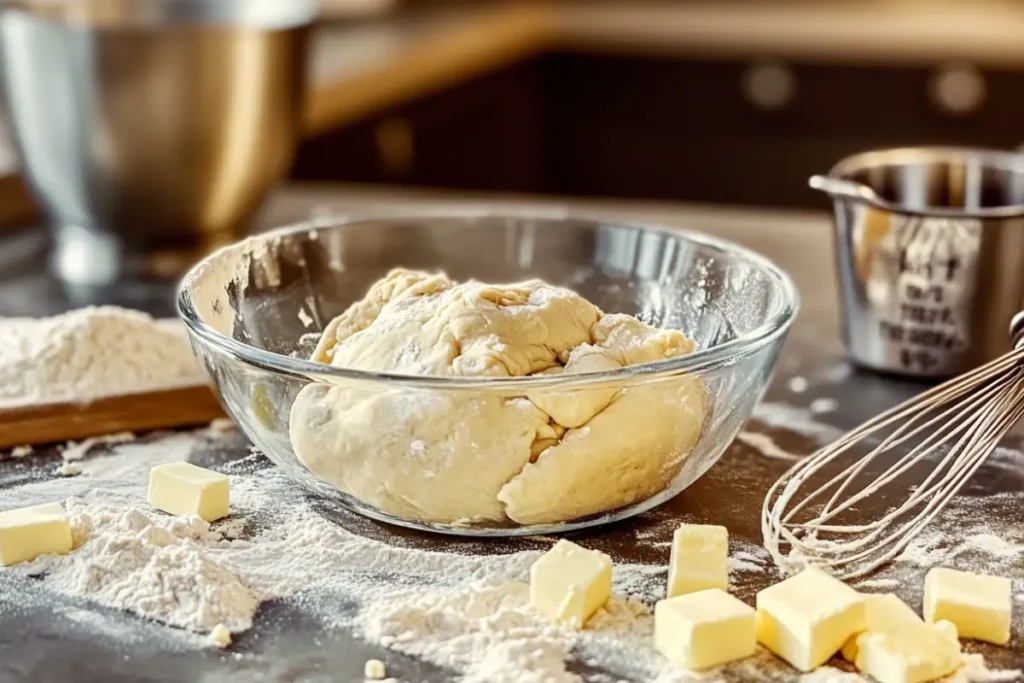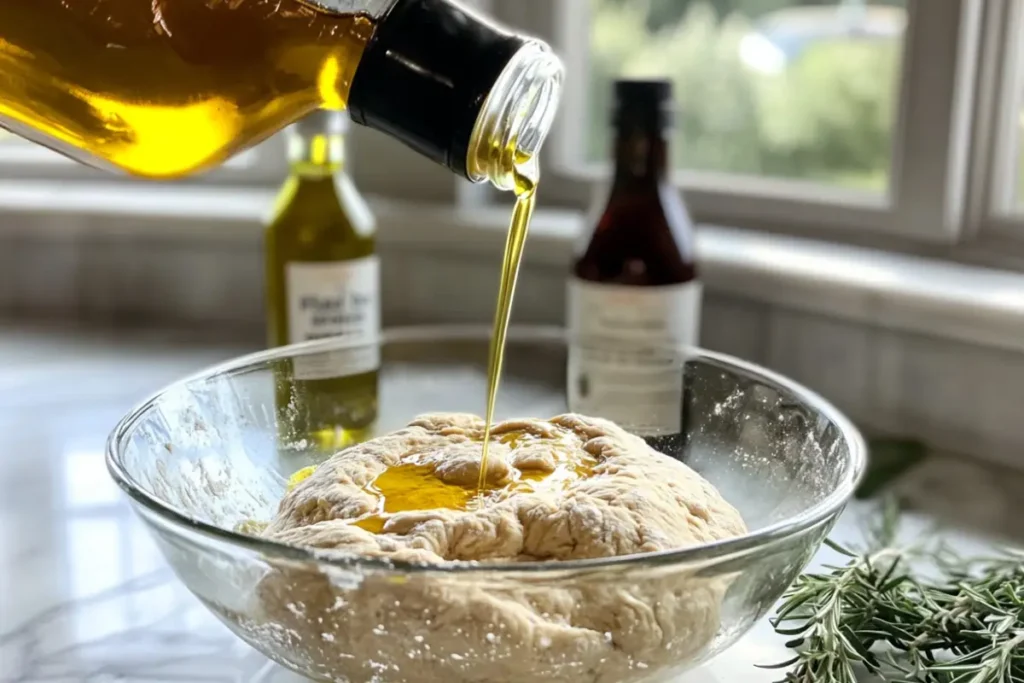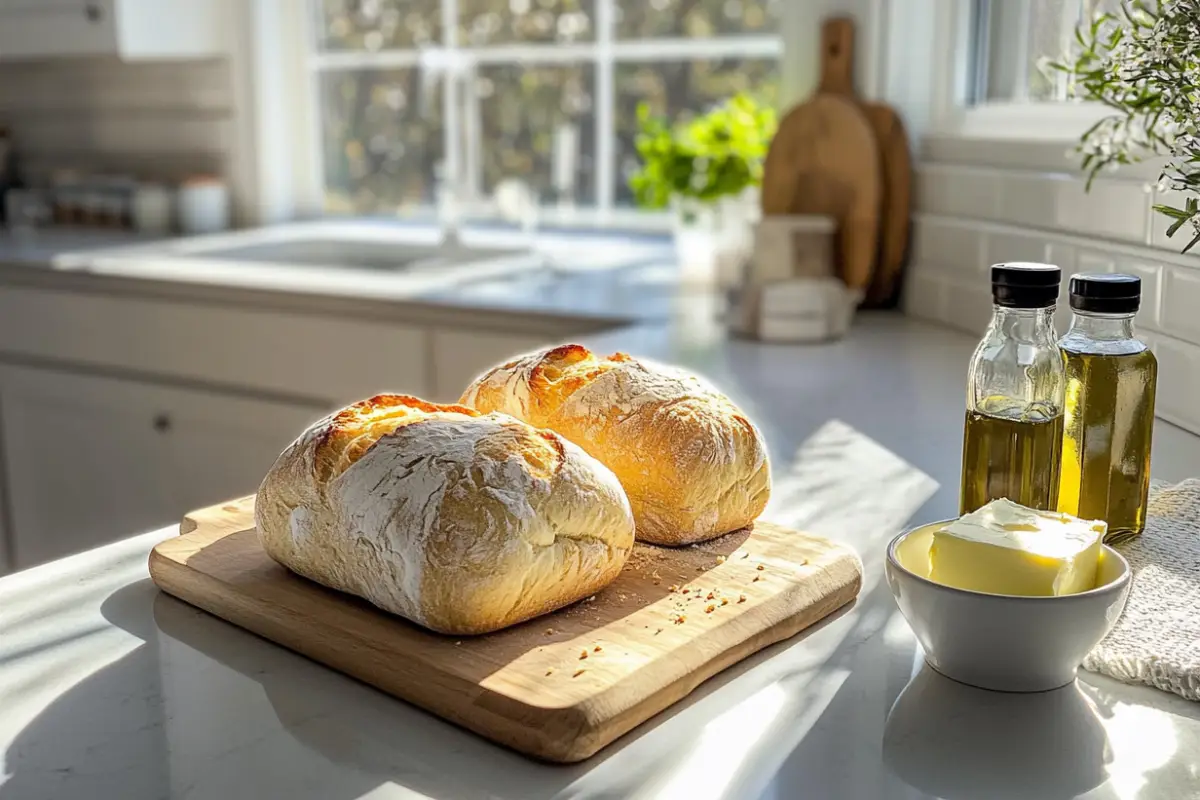Last Updated on January 22, 2025 by Souhail
Baking bread is an art and a science, with every ingredient playing a crucial role in the final result. One common question bakers often ask is, “Is it better to use oil or butter for bread?” This choice can significantly influence the flavor, texture, and shelf life of your bread. Whether you’re aiming for a soft, fluffy loaf or a rich, indulgent brioche, understanding how oil and butter affect your bread will empower you to make the best choice for your recipe.
Both oil and butter are fats, but they behave differently in baking. Butter is celebrated for its flavor and creamy texture, while oil offers moisture and extended freshness. In this guide, we’ll delve into the differences, advantages, and ideal scenarios for using oil or butter in bread. Along the way, we’ll answer common questions and provide actionable tips to help you bake bread that suits your preferences perfectly.
Table of contents
- The Role of Fat in Bread Baking
- Oil vs. Butter: Breaking Down the Differences
- When to Use Oil or Butter for Bread?
- Customizing Bread Recipes: Mixing Oil and Butter
- Pro Tips for Choosing Between Oil or Butter for Bread
- Health Benefits of Oil and Butter in Bread
- How to Choose Based on Health Goals
- FAQs: Is It Better to Use Oil or Butter for Bread?
- Serving Suggestions for Bread
- Storage and Reheating Tips for Bread
- Final Thoughts
The Role of Fat in Bread Baking
Before deciding between oil or butter for bread, it’s essential to understand what fat does in bread dough:
- Enhances Flavor: Fats like oil and butter enrich the taste of bread, adding a depth of flavor that plain flour and water can’t provide.
- Improves Texture: Fat tenderizes gluten strands, resulting in a softer crumb and less chewy texture.
- Extends Freshness: Fats help retain moisture, keeping your bread fresher for longer.
- Affects Crust: The type of fat you use influences the crust’s crispiness and color during baking.
Oil vs. Butter: Breaking Down the Differences
When answering, “Is it better to use oil or butter for bread?” it’s essential to consider their distinct properties:
Butter: The Flavor Champion

Butter is a classic choice for bread baking, particularly for enriched doughs like brioche, challah, or milk bread. It adds a rich, creamy flavor that can’t be replicated by oil. Its high saturated fat content contributes to a soft, tender crumb.
Pros of Butter:
- Adds a luxurious, buttery flavor.
- Contributes to a tender, soft crumb.
- Ideal for recipes that call for a richer texture, such as dinner rolls and brioche.
Cons of Butter:
- Contains water (about 15-20%), which slightly reduces fat content.
- Can result in a denser loaf if not balanced correctly.
- Shorter shelf life compared to oil-based bread.
Oil: The Moisture Master

Oil, especially vegetable or olive oil, is a go-to option for bread that needs to stay fresh longer. The oil is 100% fat, unlike butter, which contains water. This pure fat content helps create a softer, moister crumb that resists drying out over time.
Pros of Oil:
- Creates a moist, soft texture.
- Enhances bread’s shelf life.
- Neutral oils (like canola or vegetable oil) don’t overpower other flavors.
Cons of Oil:
- Doesn’t provide the rich flavor butter does.
- Can make the crumb slightly heavier if used excessively.
- Lacks the airiness butter contributes to some enriched breads.
When to Use Oil or Butter for Bread?
The answer to “Is it better to use oil or butter for bread?” often depends on the type of bread you’re baking:
- For Enriched Breads: Use butter to achieve a rich, indulgent flavor. Recipes like brioche, challah, and croissants benefit from butter’s creaminess.
- For Everyday Sandwich Loaves: Oil works well for sandwich bread or dinner rolls, as it ensures a moist and tender crumb.
- For Quick Breads: Neutral oils like canola or vegetable oil are ideal for banana bread or zucchini bread, where subtle flavor is needed.
Customizing Bread Recipes: Mixing Oil and Butter
You don’t have to choose exclusively between oil or butter for bread. Many bakers combine both to enjoy the best of both worlds. For example:
- Use oil for moisture and shelf life.
- Add butter for flavor and richness.
This approach works beautifully for hybrid recipes like cinnamon rolls or soft dinner rolls, ensuring both texture and taste are optimized.
Pro Tips for Choosing Between Oil or Butter for Bread
When deciding whether to use oil or butter for bread, consider these expert tips to help you achieve the best possible results in your baking.
1. Match the Fat to the Recipe
Certain bread recipes naturally lean toward either oil or butter. For example:
- Butter: Best for rich, sweet bread like brioche, challah, or croissants. Its creaminess enhances the luxurious texture these breads are known for.
- Oil: Perfect for everyday sandwich bread, focaccia, or quick bread, where a soft and moist crumb is a priority.
2. Experiment with Substitutions
If a recipe calls for butter, you can substitute it with oil, but keep in mind the flavor difference. To approximate the richness of butter, try olive oil or coconut oil, which add their own unique taste. Similarly, when substituting oil with butter, reduce the water content slightly to account for the moisture in butter.
3. Adjust for Texture Goals
- For a soft, fluffy crumb, oil is your friend because it coats the flour proteins, limiting gluten formation.
- If you want a structured, airy crumb with more defined layers, butter is the better choice.
4. Consider the Bread’s Purpose
Think about how you’ll use the bread:
- Toast or Sandwiches: Oil-based bread is less prone to crumbling and stays fresh longer.
- Special Occasions: Butter-based bread offers a richer experience, perfect for festive meals.
5. Use Quality Ingredients
Whether you choose oil or butter, the quality of the fat you use matters. Opt for:
- Extra Virgin Olive Oil: For Mediterranean bread like focaccia.
- Unsalted Butter: For precise control over the salt level in your recipe.
6. Test Your Oven’s Performance
Butter tends to brown more quickly than oil due to its milk solids. If your bread crust browns too fast, lower your oven temperature slightly or tent the bread with foil midway through baking.
7. Combine for Best Results
Don’t hesitate to use both oil and butter in a single recipe. A small amount of oil ensures the crumb stays moist, while butter provides the depth of flavor.
Health Benefits of Oil and Butter in Bread
Choosing between oil or butter for bread doesn’t just affect flavor and texture—it also has an impact on the health profile of your bread. Let’s explore the health benefits of each option to help you make informed choices that align with your dietary preferences and goals.
Health Benefits of Using Oil in Bread
- Rich in Healthy Fats
Many oils, such as olive oil and avocado oil, contain unsaturated fats, which are heart-healthy. These fats can help lower bad cholesterol (LDL) while increasing good cholesterol (HDL). - Antioxidants in Olive Oil
Olive oil, particularly extra virgin, is rich in antioxidants and anti-inflammatory compounds. This can benefit overall health and may reduce the risk of chronic diseases. - Lower Saturated Fat Content
Compared to butter, oils have a lower saturated fat content. For instance, canola oil has one of the lowest saturated fat levels among cooking oils, making it a heart-friendly choice. - Vegan and Lactose-Free
For those following a plant-based diet or avoiding dairy, oil is a natural alternative to butter without compromising on texture or softness in bread.
Health Benefits of Using Butter in Bread
- Source of Fat-Soluble Vitamins
Butter contains fat-soluble vitamins like A, D, E, and K, which support skin health, immunity, and bone strength. Grass-fed butter, in particular, is richer in these nutrients. - Natural and Minimal Processing
Unlike some oils that undergo extensive refining, butter is a minimally processed product, particularly if you choose organic or grass-fed varieties. - Contains Conjugated Linoleic Acid (CLA)
Grass-fed butter is a natural source of CLA, a compound that may have anti-inflammatory and heart-health benefits when consumed in moderation. - Energy-Dense
Butter provides a concentrated energy source, making it a good option for those needing higher caloric intake, such as athletes or individuals recovering from illness.
How to Choose Based on Health Goals
- For Heart Health: Opt for unsaturated fats like olive or avocado oil, as they promote cardiovascular health.
- For Weight Management: Use fats sparingly, regardless of type, but lean toward oil for its lower saturated fat content.
- For a Nutrient Boost: Choose grass-fed butter for its higher vitamin and CLA content or extra virgin olive oil for antioxidants.
FAQs: Is It Better to Use Oil or Butter for Bread?
Yes, you can substitute oil for butter, but the flavor and texture will change. Oil produces a moist, soft crumb, while butter adds a rich taste and structured crumb. Use a 1:1 ratio but adjust the water content slightly if the recipe relies heavily on butter’s moisture.
Neutral oils like canola or vegetable oil work best for most bread recipes. For a richer flavor, use olive oil, especially in Mediterranean bread. Avoid oils with strong flavors, like sesame or peanut oil, unless they complement the recipe.
Yes, the type of fat can affect how your bread rises. Oil creates a softer dough that may spread more, while butter adds structure, helping the bread hold its shape better during baking.
Oil prolongs the shelf life of bread by locking in moisture, while butter may lead to faster drying due to its water content. If longevity is a concern, opt for oil or combine the two.
Oil is typically healthier than butter, as it contains unsaturated fats that are better for heart health. However, if health is a concern, consider using olive oil for its beneficial fats and antioxidants.
Absolutely. Butter imparts a creamy, rich flavor, while oil (especially neutral varieties) allows other ingredients to shine. For a noticeable taste, try flavored oils like garlic or herb-infused options.
Serving Suggestions for Bread

Whether your bread uses oil or butter, how you serve it can elevate the experience. Here are some delicious ideas:
1. For Oil-Based Bread
- Dipping Oils: Serve fresh focaccia with olive oil, balsamic vinegar, and herbs for a Mediterranean touch.
- Sandwiches: Use oil-based sandwich bread for robust fillings like roasted vegetables or deli meats.
2. For Butter-Based Bread
- Sweet Spreads: Butter-rich bread pairs beautifully with jams, honey, or Nutella.
- Savory Toppings: Smear butter-based rolls with garlic butter or herb cream cheese for a luxurious treat.
3. Toast and Crust Ideas
- For oil-based bread, add a drizzle of olive oil and sea salt before toasting.
- For butter-based bread, slather on more butter and toast until golden brown for a rich snack.
Storage and Reheating Tips for Bread
Whether you’ve baked bread with oil or butter, proper storage is crucial for preserving its flavor, texture, and freshness. Here’s how to keep your bread at its best:
1. Storing Bread Made with Oil
- Room Temperature: Store in an airtight container or bread box for 2–4 days. Oil-based bread tends to stay moist longer, making it ideal for room-temperature storage.
- Freezer: Slice the bread, wrap each piece in plastic wrap, and store in a freezer bag for up to 3 months.
- Avoid Refrigeration: Refrigeration can cause bread to dry out quickly, even with the added moisture from oil.
2. Storing Bread Made with Butter
- Room Temperature: Butter-based bread is best stored at room temperature for 1–2 days, as it dries out faster than oil-based bread.
- Freezer: Wrap the loaf tightly in foil or plastic wrap and store in the freezer for up to 2 months. Allow it to thaw at room temperature before reheating.
3. Reheating Tips
- Oven: Wrap the bread in foil and warm at 350°F (175°C) for 5–10 minutes to restore its softness.
- Toaster: Slice and toast to revive crispness and flavor.
- Microwave: For a quick reheat, wrap bread in a damp paper towel and microwave for 10–15 seconds to regain moisture.
Final Thoughts
Choosing between oil or butter for bread is not just a matter of preference but a decision that influences the flavor, texture, and shelf life of your loaf. Whether you opt for the rich creaminess of butter or the extended freshness provided by oil, both fats have their place in the bread-making process. By understanding their unique properties, you can customize recipes to suit your taste and dietary needs, ensuring every loaf you bake is a success.
If you’re feeling inspired to experiment, why not explore a new recipe that highlights the versatility of oil in bread baking? Check out How to Quickly Make Banana Bread Without Butter for a delicious, easy-to-make treat that substitutes butter with healthier options. This article is packed with tips to help you whip up moist, flavorful banana bread in no time.
Now, it’s your turn to get baking! Be sure to share your results, and if you have any questions, feel free to ask them. Additionally, we’d love to hear about your favorite bread recipes in the comments below. So, let’s keep the conversation going, and as always, happy baking!

